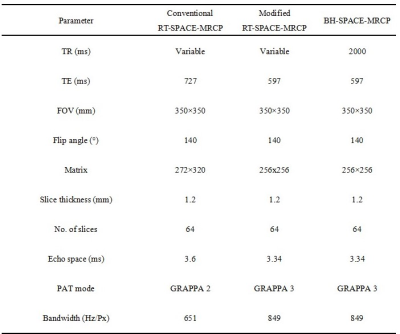1252
MRCP at 1.5 T: comparing image quality and acquisition time between respiratory-triggered and breath-hold SPACE sequences1Xi'an Daxing Hospital, Xi'an, China, 2Siemens Healthineers, Ltd., Xi'an, China
Synopsis
This study used magnetic resonance cholangiopancreatography (MRCP) to compare the image quality and acquisition time of conventional respiratory-triggered (RT), modified RT, and breath-hold (BH) sampling perfection with application-optimized contrasts using different flip evolutions (SPACE) sequences in patients with biliary and pancreatic disorders. Our results suggested that modified RT-SPACE-MRCP sequence can significantly reduced acquisition time and had better image quality. The MRCP sequence can be selected flexibly according to the patient's situation to obtain good diagnostic images.
Introduction/Purpose
Magnetic resonance cholangiopancreatography (MRCP) has many advantages, including reducing the need for invasion, ionizing radiation, and contrast administration in the pancreaticobiliary ducts. Most initial studies of this technique had focused on breath-hold (BH)-3D-MRCP acquisition sequences, which decrease the spatial resolution and result in non-isotropic voxel datasets [1,2]. Respiratory-triggered (RT)-3D-MRCP sequence, which can acquired higher spatial resolution but often need take more than 6 minutes despite use of a parallel acquisition technique [3]. A sampling perfection with application-optimized contrasts using different flip angle evolutions (SPACE) sequences has also been noted to improve image quality and the contrast-to-noise ratio [3]. For example, the BH-3D-SPACE-MRCP sequence, which was modified from the RT-3D-SPACE-MRCP sequence, had an acquisition time of approximately 18 seconds and produced good quality images [4]. This study aimed to compare both the acquisition time and MRCP image quality of conventional RT-SPACE-MRCP, modified RT-SPACE-MRCP, and BH-SPACE-MRCP and to assess the diagnostic performance of each technique in patients with biliary and pancreatic disorders.Method
We enrolled 58 patients (32 males and 26 females) in this study. Their mean age was 48.3±19.5 years (age range: 15-83 years). Based on clinical manifestations, medical history, physical examination, or abdominal ultrasound, MRCP examination was performed in patients with suspected biliary and pancreatic disorders. All patients underwent conventional RT-SPACE-MRCP, modified RT-SPACE-MRCP, and BH-SPACE-MRCP on a 1.5 T MR scanner (MAGNETOM Aera, Siemens Healthineers, Erlangen, Germany) using an 18-channel body coil and a 32-channel spine coil. The parameters of 3 different types of SPACE sequences were showed in Table 1. The acquisition time of each MRCP sequence was noted.Result
There was a significant difference in the mean acquisition time between conventional RT-SPACE-MRCP, modified RT-SPACE-MRCP, and BH-SPACE-MRCP (168.9±34.9 sec vs. 42.8±12.1 sec vs. 18 seconds, P < .001). There was also a significant difference in the SNR and CNR of the 3 groups (P < .05)(Figure 1). However, there was no statistical difference (P > .05) between the 3 groups regarding overall image quality, image sharpness, background suppression, and visualization of the pancreaticobiliary system. The interobserver agreement(IOA) was also high among all 3 sequences (0.68-0.91, 0.65-0.86, and 0.61-0.83, respectively).Discussion/Conclusion
In this study, we performed 3 different MRCP scanning sequences on patients with biliary and pancreatic disorders to compare the acquisition time and image quality. Compared with conventional RT-SPACE-MRCP, the modified RT-SPACE-MRCP sequence, which used GRAPPA 3, led to a shorter data acquisition time than conventional RT-SPACE-MRCP and also produced the better image quality. For this reason, our study results may be of clinical value as they can help improve the overall workflow of pancreaticobiliary MR imaging if the patient cannot hold their breath. Furthermore, BH-SPACE-MRCP has shortest acquisition time and good quality images. In conclusion, conventional RT-SPACE-MRCP can be replaced with modified RT-SPACE-MRCP or even BH-SPACE-MRCP because it provides comparable image quality in a significantly shorter time. It is necessary to select the appropriate MRCP sequence according to the patient’s situation to save scanning time, improve the examination success rate, and also enable the patient to have a better examination experience.Acknowledgements
We thanks Shaoyu Wang from Siemens Healthineeers, Ltd., Xi’an, China, for technical support.References
1. Matos C, Cappeliez O, Winant C, et al. MR imaging of the pancreas: a pictorial tour[J]. Radiographics 2002;22(1):e2.
2. Sodickson A, Mortele KJ, Barish MA, et al.Three-dimensional fast-recovery fast spin-echo MRCP: comparison with two-dimensional single-shot fast spin-echo techniques[J]. Radiology 2006;238(2):549-559.
3. Takeshi N, Masafumi K, Natsuki M, et al. Usefulness of the SPACE pulse sequence at 1.5T MR cholangiography: comparison of image quality and image acquisition time with conventional 3D-TSE sequence[J]. J Magn Reson Imaging 2013;38:1014-1019.
4. Chen Z, Sun B, Duan Q, et al. Three-Dimensional BreathHold MRCP Using SPACE Pulse Sequence at 3 T: Comparison With Conventional Navigator-Triggered Technique[J]. AJR Am J Roentgenol 2019;213:1247-1252.
Figures

